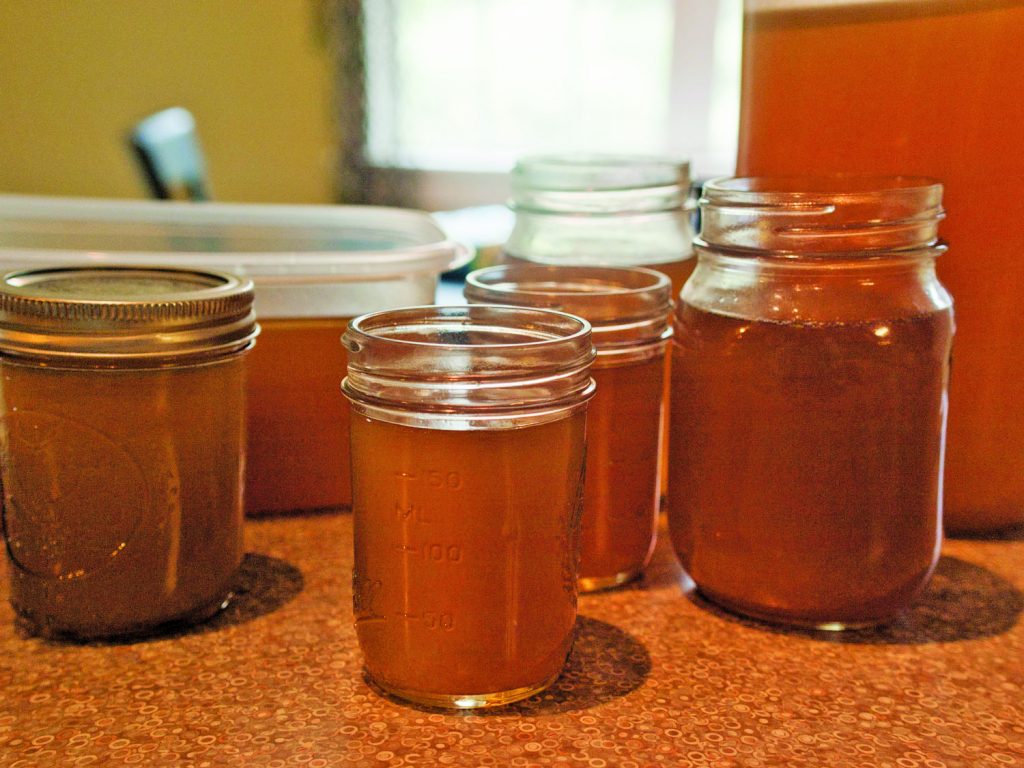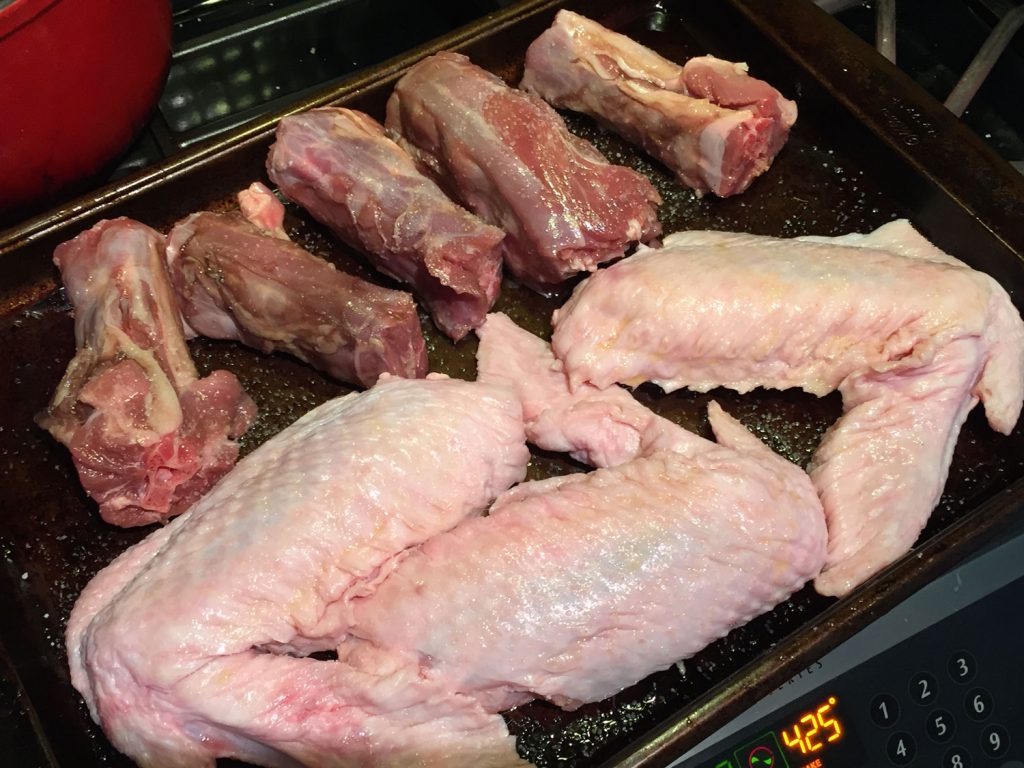Television has brought professional cooking into our homes. When Julia Child warbled into our homes many years ago, gourmet cooking was almost a mystical experience. Today, networks dedicated to food make gourmet-cooking ordinary, almost expected. Live action shows with speed challenges challenge us to make a three-course gourmet dinner with Dr. Pepper and peanut shells. Children find themselves in pastry competitions and home cooks compete to be the worst cook in America, a dubious distinction at best. I’ve seen more than one of these top-notch celebrity chefs pop the top on a box of stock. When you’ve got to get a meal on the table in 30 minutes, convenience is vital.

Always make more than you need; then freeze or use a pressure canner to can the surplus. When Ole’ Man Winter rolls around, you’ll be glad you did.
Today’s cooks are among the luckiest; a box of stock is actually delicious. You can get almost any flavor, and nowadays most manufactures offer a low sodium version and some offer no salt at all (my favorite). Unless a tyrannical French chef runs your kitchen, there is absolutely no good reason to make your own stock. Truth be told, most commercial stock is as good as homemade. There, I’ve said it. Prepare the guillotine.
However, sometimes I long for the black and white days of Julia. When convenience was vulgar and canned stock tasted of metal. When nostalgia runs rampant, (or snow is forecast), I pull out my stockpot and make stock. A pot of stock simmering on the stove makes my house smell amazing, and knowing I’ve got a few quarts in the freezer makes me feel safe and secure.
There are many reasons to make your own stock: most people feel it tastes better; everyone would agree it costs less. My motivation for making stock is simple; good stock reveals the talent and skill of the cook. If you can make good stock, the world is your oyster and people don’t care if you are pretentious.
Look carefully at my recipes; you’ll notice a few commonalities. First, I always brown the meat/bones for my stock. Browning the meat adds deeper color and more importantly deeper flavor. This can be accomplished on the stove, but I am lazy by nature and prefer to do things the easy way, hence the oven.

Use kitchen tongs to squeeze the cooked vegetables; we don’t want to waste a drop of flavor.
I prefer not to roast the veggies before stock making; roasting them adds a level of sweetness that I don’t like. However, it’s worth browning or sautéing the vegetables to see what you prefer; stock, like art, is subjective.
I always use a combination of onions, carrots, celery, thyme, parsley, bay and peppercorns. I add garlic to beef stock and parsnips to poultry stock. I like my veggie stock to have a hint of fennel, so I toss in a bulb. Other than that, it’s a simple ratio of 4:1, meat to vegetables. Of course, eyeballing, works best for me.
Once you have a supply of stock stockpiled (sorry), doors will begin to open you’ll find a myriad of ways to use it. Add a roux of flour and butter to make quick, homemade gravy. Braise a chuck roast in homemade beef stock; use veggie stock to make creamy risotto or simply simmer chicken and pasta in chicken stock for homemade chicken noodle soup.
Store cooled stock ref
rigerated for 2 days. Freeze it in a silicone muffin tins or freezer safe containers. Frozen stock keeps about 2 months. Concentrated stock can be frozen in an ice cube tray and stored in heavy-duty freezer bags. If you have a pressure canner, consider canning your stock for future use. Please remember, stock is a low-acid food and unsuitable for a water bath canner; you must use a pressure canner.
However you choose to use your stock, use it triumphantly and with pride. Julia would approve.
Slow Cooker Beef Broth
- Yield: about 2 quarts
- 4 pounds of a combination of marrow bones and meaty bones, such as ribs, shin, neck or tail
- Kosher Salt
- 2 onions, washed and quartered, no need to peel
- 2 carrots, washed and cut into thirds
- 2 ribs of celery, washed and cut into thirds
- 4 or 5 garlic cloves, gently smashed
- 3 sprigs of fresh thyme
- 2 sprigs of fresh parsley
- 2 bay leaves
- 10 black peppercorns
- ½ teaspoon of salt
- Water, between 6 and 8 cups
Preheat the oven to 400°F. Lay the bones on a baking sheet, sprinkle with salt and roast the bones until they are brown turning once. Roasting time depends on the type of bones, anywhere from 30 minutes to an hour. Make sure your oven is clean, this is a smoky job, be prepared to reduce oven heat if the fat begins to smoke.

Consider buying turkey wings and necks to make stock before Thanksgiving rolls around. Stick it in the freezer and pat yourself on the back.
When the bones are brown, remove them from the baking sheet and discard the fat; save the brown bits. Add the beef bones and brown bits to a large slow cooker; add the vegetables, herbs, peppercorns and salt.
Fill the slow cooker with water; cook on high for 2 hours, then reduce the heat to low and cook for 10 hours.
Line a colander with cheesecloth and strain the stock into a big bowl. Remove the bones, then gather the edges of the cheesecloth and squeeze the vegetables with tongs to remove any last drops of stock.
Ladle the broth into storage containers, pressure can according to directions or freeze for up to 6 months. If freezing, be sure to leave 1 inch of room for expansion.
Turkey or Chicken Stock
Yield: about 2 quarts
- 4 pounds of turkey (or chicken) wings, necks and backs
- Kosher Salt
- ½ cup dry white wine
- 1 onion washed and quartered, no need to peel
- 2 leeks, washed and cut into pan sized pieces
- 2 carrots, washed and cut into thirds
- 1 parsnip, washed and cut into thirds
- 2 ribs of celery, washed and cut into thirds
- 3 sprigs of fresh thyme
- 2 sprigs of fresh parsley
- 2 bay leaves
- 10-15 black peppercorns (I like peppery stock, use less if you prefer it less spicy)
- ½ teaspoon salt
- Water, between 6 and 8 cups
Preheat the oven to 400°f. Lay the poultry on a baking sheet and sprinkle with Kosher salt. Roast the poultry until it is brown, turning once. This takes between 30 and 45 minutes. Reduce the heat if the fat begins to smoke.
When the bones are golden brown, remove them from the pan at place in a large stockpot. Pour off all the grease (and none of the brown bits) from the baking sheet. Pour the wine on the baking sheet while it is still hot and using a spoon, scrape up all the brown bits of poultry goodness. Pour the liquid and bits from the baking sheet into the stockpot with the poultry parts.
Add the vegetables, herbs, salt and pepper. Add enough water to cover the contents of the pot by 2 inches. Place over medium high heat and bring to a boil; immediately reduce the heat to a bare simmer and let it gently simmer for 3 to 4 hours. Skim any foam that rises to the top.
Line a colander with cheesecloth and strain the stock into a big bowl. Remove the poultry, then gather the edges of the cheesecloth and squeeze the vegetables with tongs to remove any last drops of stock.
Ladle the broth into storage containers, pressure can according to directions or freeze for up to 6 months. If freezing, be sure to leave 1 inch of room for expansion.
Vegetable Stock
Yield: about 2 quarts
- 3 or 4 shallots, washed and quartered, no need to peel
- 4 leeks, washed and cut into thirds
- 4 cloves of garlic, gently smashed
- 2 carrots, washed and cut
- 1 parsnip, washed and cut
- 3 ribs of celery, washed cut
- 1 fennel bulb, washed and cut, no need to core
- 1 long fennel frond, optional
- 3 sprigs of fresh thyme
- 3 sprigs of fresh parsley
- 2 bay leaves
- 10 peppercorns
- ½ teaspoon of salt
- Water, about 8 cups
Vegetables for stock need to be cut a bit smaller than vegetables for a meat stock, but don’t cut them too small or you will have mush by the end of the cooking period. 1 to 2 inch pieces is about right.
Place all of the vegetables in a large stockpot, cover with water by 2 inches. Bring to a boil, then immediately reduce to a simmer.
Simmer for 30 to 45 minutes.
Line a colander with cheesecloth and strain the stock into a big bowl; then gather the edges of the cheesecloth and squeeze the vegetables with tongs to remove any last drops of stock.
Return the strained stock to the stockpot and bring to a medium-low boil for about 30 minutes, to reduce and intensify the flavor.
Ladle the broth into storage containers, pressure can according to directions or freeze for up to 6 months. If freezing, be sure to leave 1 inch of room for expansion.







